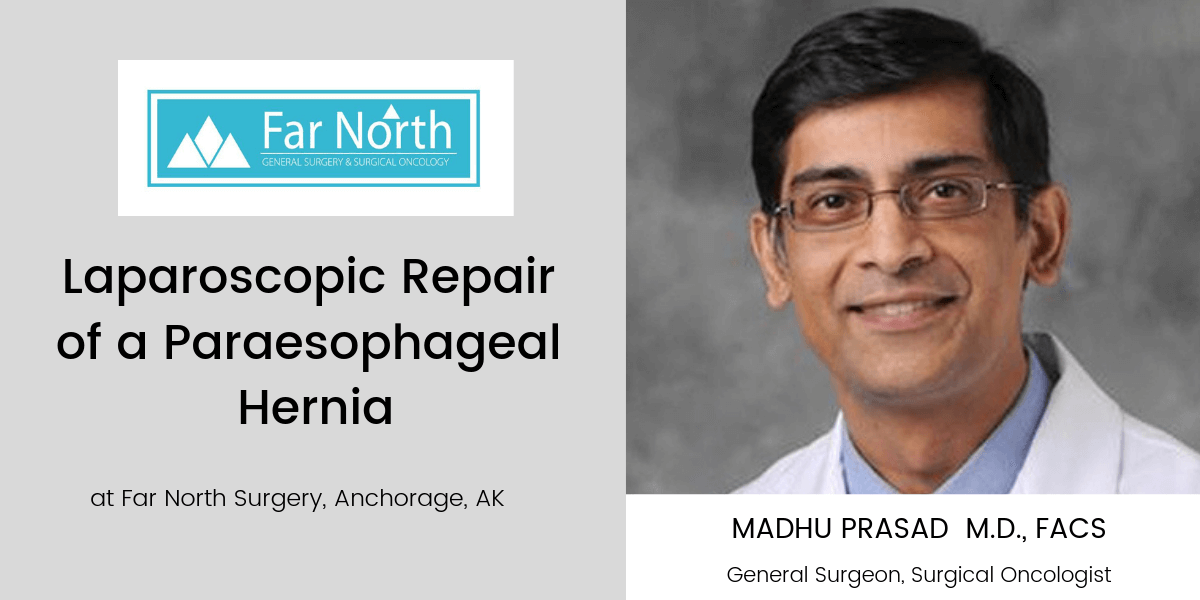


Laparoscopic repair of a paraesophageal hernia is a minimally invasive surgical procedure where a few small keyhole incisions are made in your abdomen to squeeze the herniated part of the stomach back to its original position. Laparoscopic repair procedures in paraesophageal hernia cases result in significantly fewer complications and faster recovery. Dr. Madhu Prasad is a trusted general surgeon in Anchorage, AK, having years of experience in treating hernias with successful outcomes.
A paraesophageal hernia is the less common type of hiatal hernia in which the esophagus and stomach stay in their normal locations, but a part of the stomach moves upward through the small opening in the diaphragm—the hiatus—moving it next to the esophagus. *Diaphragm – The muscular wall separating the chest cavity from the abdomen.
We don’t know the exact reason for developing paraesophageal hernias. However, there are some risk factors associated with causing the weakening of diaphragm muscles that could allow the stomach to enter the area above the diaphragm. Risk factors for the weakening of diaphragm muscles include:
At first, paraesophageal hernias may not cause any symptoms. These asymptomatic hernias may go unnoticed and do not require surgery. However, symptomatic paraesophageal hernias are a cause of concern and need repair before they progress into severe problems like your stomach getting "strangled," or blood flow restriction. Following are the symptoms of a paraesophageal hernia indicating that it needs repair:
If you have been diagnosed with a paraesophageal hernia and you develop severe pain in the chest or abdomen, feel nausea, experience vomiting, or are unable to pass gas or have a bowel movement, you may have developed a strangulated hernia. These signs can indicate an emergency. Call your doctor immediately.
Generally, a paraesophageal hernia is diagnosed with a specialized X-ray (using a barium swallow) to see the esophagus or with an endoscopy to see the hernia directly.
In a laparoscopic repair of a paraesophageal hernia, a few small (5 to 10 millimeter) incisions are made in the abdomen then a laparoscope and other surgical instruments are inserted into the abdomen. The laparoscope has a light and a small camera attached to it that guides the surgeon by transmitting a picture of the internal organs to the monitor.
During surgery, the herniated part of the stomach is moved back to its original position in the abdominal cavity, and the hiatal opening in the diaphragm is closed to prevent the stomach from re-herniating. In many cases, after the opening in the diaphragm is closed, patients have to go under fundoplication, in which the top of the stomach (the fundus) is wrapped around the bottom of the esophagus. General anesthesia is given to you before the surgery to put you to sleep during the entire operation.
The advantages of laparoscopic surgery of a paraesophageal hernia are:
Laparoscopic repair of a paraesophageal hernia is an outpatient procedure though it requires you to stay in the hospital for 1-2 days.
Patients that have undergone a laparoscopic repair of a paraesophageal hernia usually take about four weeks to recover completely. However, hard labor and heavy lifting should be avoided for up to 3 months.
At Far North Surgery, we’re committed to providing quality care and shorter recovery time to our patients. We are a team of qualified and experienced general surgeons utilizing only the most advanced surgical equipment and procedures to achieve successful results. Call us at 907-276-3676 to get the best treatment for a paraesophageal hernia, or to ask questions you may have. You can also fill out our 1-minute contact form here.